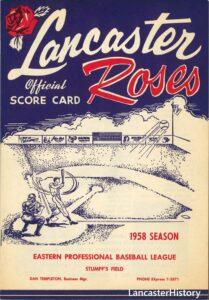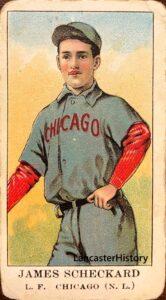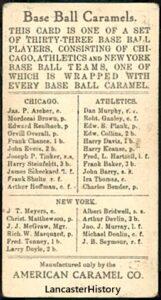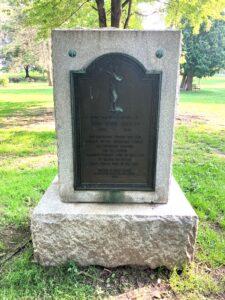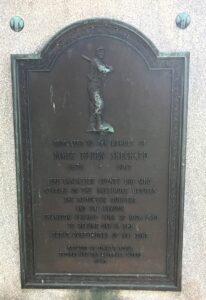The Lancaster Red Sox and a Local Two-Time World Series Champion
Play Ball!
When most people think of early organized baseball in Lancaster, the first team that usually comes to mind is the Lancaster Red Roses. That team existed intermittently under various major league teams and minor league affiliations between 1906 and 1961. The most well-known version of the team was founded in 1940 and played until 196. The team played at Stumpf Field located along Fruitville Pike in Manheim Township. At various times, the team was affiliated with the Philadelphia / Kansas City Athletics, Brooklyn Dodgers, Detroit Tigers, Chicago Cubs, and St. Louis Cardinals.
Baseball in Lancaster actually had its beginnings in the late nineteenth century. In 1884, the Lancaster Red Stocking of the short-lived Keystone Association and the Lancaster Ironsides of the Eastern League. Although a variety of teams called Lancaster their home during the late nineteenth and early twentieth centuries, a long dry spell in the late 1910s and 1920s allowed a new team and new league to try its luck in Lancaster.
Right Photo: For the 1958 season, the Red Roses were an affiliate of the Detroit Tigers, John Pesky, Manager. Pesky played the majority of his ten-year major league career with the Boston Red Sox, but spent three seasons with the Tigers near the end of his career. LancasterHistory.
Lancaster Red Sox
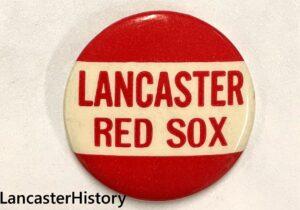
In 1932, a new team by the name of the Lancaster Red Sox, an affiliate of the Inter-State League, began play. The league consisted of four teams: the Stroudsburg Poconos, Pottstown Legionaries, Tamaqua / Slatington Dukes, and Lancaster Red Sox. The Inter-State League existed beginning in 1895 through 1952 but only played a total of 28 seasons during that period. Teams were typically placed in small towns in Pennsylvania and surrounding states. The league was unaffiliated with any major league team for most of its existence; however, it was considered to be a Class B minor league in 1913 and between 1940 and 1952.
Economic problems related to the Great Depression resulted in the team ceasing operations on June 17, 1932 after only 23 games into the 1932 season. The league disbanded a few days later on June 20. The league returned in 1939 with only four teams but added the Lancaster Red Roses in 1940.
During this period, a number of professional Negro League baseball teams played exhibition games against local all-white teams, including the Lancaster Red Sox. The Baltimore Black Sox, an independent professional Negro League team active between 1913 and 1936, were scheduled to play the Red Sox on the afternoon of Sunday, May 1; however, the game was rained out and could not be rescheduled before the home team ceased operations in June.
Jimmy Sheckard
Although short-lived, the Lancaster Red Sox were managed by a local ball player who played on two World Series championship teams. During his seventeen-year major league career, Samuel James Tilden (Jimmy) Sheckard achieved a number of notable milestones but was never able to consistently put those talents together for a whole career. Born in York County on November 23, 1878, Sheckard’s family moved to Columbia, Lancaster County when he was a young boy.
As an outfielder, Sheckard began his seventeen-year major league career with the Brooklyn Bridegrooms in 1897. He played with the Brooklyn Bridegrooms, NL (1897-1898); Baltimore Orioles, NL (1899); Brooklyn Superbas, NL (1900-1902); Baltimore Orioles, AL (1902); Brooklyn Superbas, NL(1903-1905); Chicago Cubs, NL (1906-1912); St. Louis Cardinals, NL (1913); and Cincinnati Reds, NL (1913).
In 7,605 plate appearances, he batted .274 with 813 runs batted in and 56 home runs. He appeared in 2118 games and had 2080 hits. His best season at the plate was 1901 when he hit .354 and led the National League with 19 triples. He also drove in 104 runs, hit 11 home runs and led the league in slugging percentage. In that same season he became the first player in the 20th century to hit grand slam home runs in two consecutive games, an amazing feat, especially in the Deadball Era. It would be 77 years until another National League player, Phil Garner, matched the accomplishment.
Sheckard led the National League in stolen basis twice with 77 in 1889 and 67 in 1903. He was also the NL home run champ in 1903 with 9, making him the first player to lead the league in homers and stolen bases in the same season. The only other players to achieve that feat in the major leagues are Ty Cobb and Chuck Klein. In the middle of his career he twice led the league in sacrifice hits (1906 and 1909) and still holds the National League record for sacrifice hits in a season with 46. Later in his career, he led the league in walks twice (1911 and 1912), and in runs scored (in 1911). His substantial number of walks (1135 over his entire career) gave him an impressive on-base percentage of .375
Sheckard was also an outstanding defensive player. He holds the all-time single season major league record for double plays at two separate positions. He had 12 double plays as a left fielder in 1911 and 14 as a right fielder in 1899.
Sheckard played for the Chicago Cubs from 1906 to 1912, which was their greatest era. They won the World Series in 1907 and1908. They also won National League pennants in 1906 (when they went 116-36) and 1910. Sheckard, however, was not able to play as well for them as he had done earlier in the decade. His best year with the Cubs was 1911, a year in which the Cubs did not win the pennant, although Sheckard led the league with 121 runs and 147 walks.
Remembering Jimmy Sheckard
After coaching for the Cubs, he served as athletic director at the Great Lakes Naval Training Station during WWI. He later returned to Lancaster where he coached baseball for Franklin & Marshall College for the 1919 season before managing the Lancaster Red Sox in the Inter-State League in 1932 and the All-Lancaster Nine in the City and County Baseball League in 1936. He died tragically at the age of 68 on January 15, 1947 after being hit by a car. At the time of his death he lived at 334 West Orange St. in Lancaster. He is buried in Laurel Hill Memorial Gardens in Columbia.
A monument in Buchanan Park along the Buchanan Avenue side of the park stands as a silent testimonial to one of Lancaster’s earliest and most celebrated professional athletes. The plaque on the monument reads: ”Dedicated to the memory of James Tilden Sheckard (1878-1947) The Lancaster County boy who starred on the Baltimore Orioles, The Brookly Dodgers and the famous champion Chicago Cubs of 1906-1910 to become one of the great outfielders of all time. Erected by Jimmy’s local friends and the baseball world, 1947.”
Now on Display
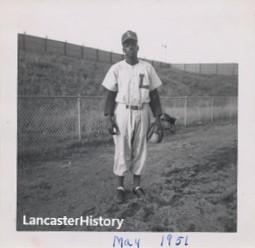
On your next visit to LancasterHistory make sure to visit our newest special exhibition in Ryder Hall. “Open the Door: Baseball’s Color Line in Central Pennsylvania” includes objects and photographs that document the integration of baseball on both a local and national level. Highlights include stories of teams like the Harrisburg Giants of the Eastern Colored League and men like Keith Kelley who integrated the Lancaster Red Roses.
“Open The Door” will be on display at LancasterHistory in Stoudt Gallery from June 9 – August 30, 2025. Admission to the exhibit is included with the purchase of a General Admission ticket or Exhibitions-Only ticket. LancasterHistory Members receive complimentary admission.
From Object Lessons

